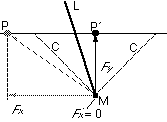 |
 |
 |
 |
 |
 |
 |
 |
 |
|

The
|
 |
|

|
 |
|

No other ground forces are applied to the creature to constrain movement in any direction.
|
 |
|
foot may be in full or partial contact with the ground, depending on which monitor points are in
|
 |
|
ground contact.
|
It is free to pitch, roll and yaw and to slip within the described constraints
|
 |
|
provided by the friction cones. This contrasts with many approaches in animation and in robotics,
which use planar dynamics or place less realistic constraints on the motion of the foot while in
contact with the floor [HF77, FM87, KKI90, KT91, CHP92,VFV92, SC92, Hod+9].
|
 |
|
|
|
 |
|
The most complex human model used, shown in Figure 2.9, has 19 degrees of freedom including
|
 |
|
ball-and-socket hips, 2 DOF ankles and a jointed torso.
|
All other joints are modeled using  1 1
|
 |
|
DOF.
|
Mass and inertia parameters are realistic for a human model and are from taken from
|
 |
|
[WH95].
|
Several other simpler human models with fewer DOFs are also used throughout our
|
 |
|
experiments in order to reduce simulation time requirements. The simplest of these has 12 DOFs,
with 2 DOF hips (pitch and roll but no yaw), no arms, and a rigid torso which incorporates the
mass and inertia parameters for fixed arms in the reference position of Figure 2.9.
|
 |

 1
2
3
4
5
6
7
8
9
10
11
12
13
14
15
16
17
18
19
20
21
22
23
24
25
26
27
28
29
30
31
32
33
34
35
36
37
38
39
40
41
42
43
44
45
46
47
48
49
50
51
52
53
54
55
56
57
58
59
60
61
62
63
64
65
66
67
68
69
70
71
72
73
74
75
76
77
78
79
80
81
82
83
84
85
86
87
88
89
90
91
92
93
94
95
96
97
98
99
100
101
102
103
104
105
106
107
108
109
110
111
112
113
114
115
116
117
118
119
120
121
122
123
124
125
126
127
128
129
130
131
132
133
134
135
1
2
3
4
5
6
7
8
9
10
11
12
13
14
15
16
17
18
19
20
21
22
23
24
25
26
27
28
29
30
31
32
33
34
35
36
37
38
39
40
41
42
43
44
45
46
47
48
49
50
51
52
53
54
55
56
57
58
59
60
61
62
63
64
65
66
67
68
69
70
71
72
73
74
75
76
77
78
79
80
81
82
83
84
85
86
87
88
89
90
91
92
93
94
95
96
97
98
99
100
101
102
103
104
105
106
107
108
109
110
111
112
113
114
115
116
117
118
119
120
121
122
123
124
125
126
127
128
129
130
131
132
133
134
135

